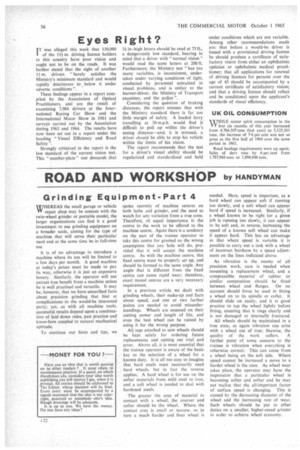Eyes Right?
Page 58

If you've noticed an error in this article please click here to report it so we can fix it.
IT was alleged this week that 150,000 I of the 13+ m. driving licence holders in this country have poor vision and ought not to be on the roads. It was further stated that the sight of another
m. drivers "barely satisfies the Ministry's minimum standard and would rapidly deteriorate to below it under adverse conditions ".
These findings appear in a report compiled by the Association of Optical Practitioners, and are the result of examining 7,984 drivers at the International Racing Car Show and the International Motor Show in 1961 and surveys carried out by the Association during 1963 and 1964. The results have now been set out in a report under the heading "Visual Efficiency and Road Safety ".
Strongly criticized in the report is the low standard of the current vision test. This "number-plate" test demands that 3+ in.-high letters should be read at 75 ft., a dangerously low standard, bearing in mind that a driver with "normal vision" would read the same letters at 200 ft. Furthermore, the Ministry test "has too many variables, is inconsistent, undertaken under varying conditions of light, conducted by personnel untrained in visual problems, and is unfair to the learner-driver, the Ministry of Transport examiner, and the pokice ".
Considering the question of braking distances, the report stresses that with the Ministry standard there is far too little margin of safety. A loaded lorry travelling at 30 m.p.h. would find it difficult to pull up within the driver's seeing distance—and, it is stressed, a driver should be able to stop his vehicle within the limits of his vision.
The report recommends that the test for a driver's visual ability should be regularized and standardized and held under conditions which are not variable. Among other recommendations made are: that before a would-be driver is issued with a provisional driving licence he should produce a certificate of satisfactory vision from either an ophthalmic optician or ophthalmic medical practitioner; that all applications for renewal of driving licences for persons over the age of 45 should be accompanied by a current certificate of satisfactory vision; and that a driving licence should reflect and be conditional upon the applicant's standards of visual efficiency.
UK OIL CONSUMPTION
IX71-11LE motor spirit consumption in the V V first six months of this year increased from 4,764,507 tons (last year) to 5,125,303 tons, the increase of 7-6 per cent was not so great as the first half of 1964 over the same period in 1963.
Road haulage requirements were up again. Sales of dery rose by 6 per cent from 1.787,966 tons to 1,894,946 tons.












































































































































































